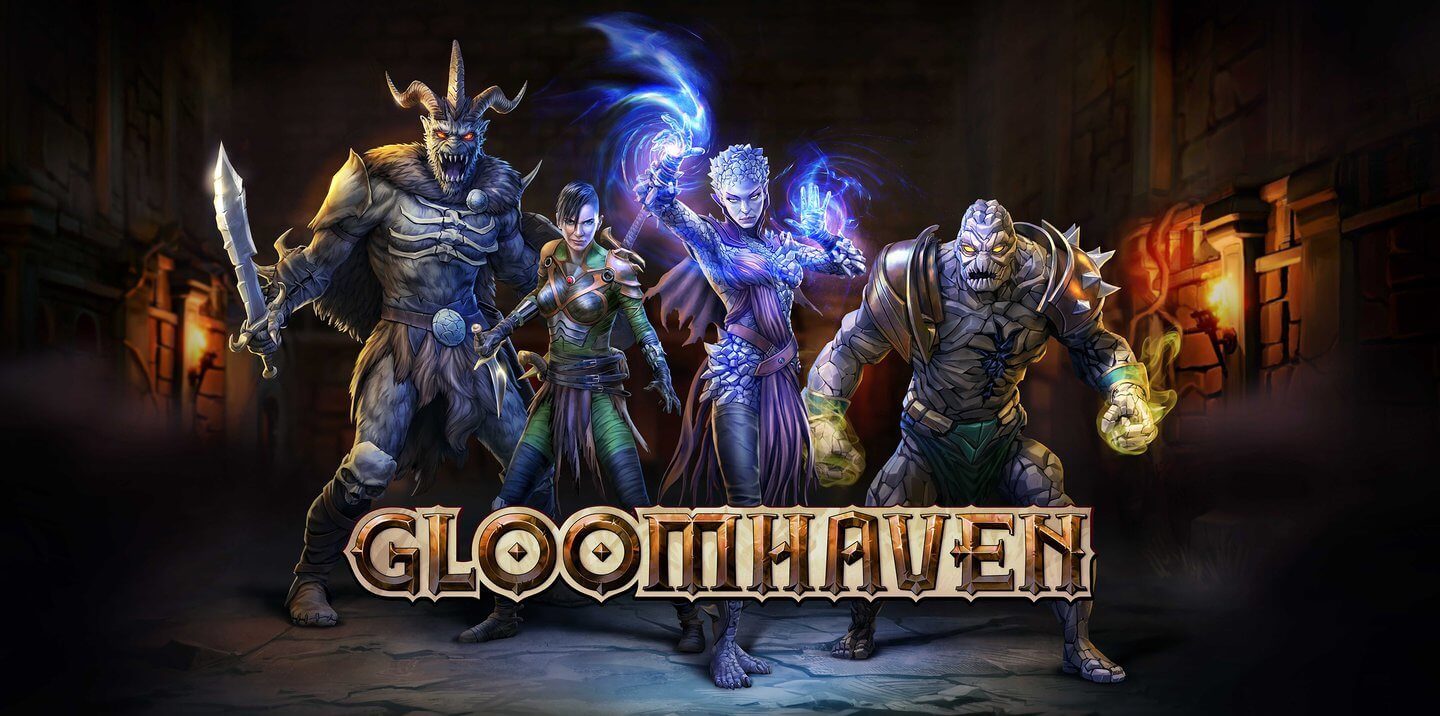WHAT TO EXPECT:
Faithful and comprehensive digital adaptation. Layered card-deck mechanics. Deep and complex turn-based tactical combat. Requires the synergising of card pairs. Supporting elements of Strategy. Elements of RPG party management. Compact dungeon-crawling. Guildmaster mode that is accessible and plays like a sandbox. Campaign mode that is difficult but with linked story quests. Small pool of fixed inventory. Some element of pre-determination and puzzle-like encounters. Command and switch out up to 17 mercenaries. Very forgiving design. Some reversion (undo) features. Hexagonal grid maps. Amazing array of internal achievements. Table-top look and feel. Considerable replay value. Just out of Early Access. Singleplayer and up to 4 player online coop.
ACHIEVEMENTS: NONE. BUT LIKELY COMING.
STATUS: JUST RELEASED. WILL NEED SUPPORTING.
WHO FOR/WHEN TO BUY: FOR FANS OF THE BOARDGAME OR THOSE NOT CHALLENGE AVERSE.
THE LOWDOWN:
Gloomhaven is the digital adaptation of an award-winning strategy boardgame by Isaac Childres. A combination of card-driven, turn-based tactical combat and compact dungeon-crawling. With abstracted elements providing adventuring services, and minor character and party management. Set in a dark fantasy world with a nomadic aesthetic. Where players take a group of up to four mercenaries on a series quests to defeat a myriad of enemies and level-up their characters while hunting for treasure.
TWO MODES ARE BETTER THAN ONE
There are two game modes in Gloomhaven: Campaign and Guildmaster. Both possess a similar format and structure, but with a number of subtle differences. The GM mode plays more like a sandbox with generic quests when compared to the campaign. Which consists of up to 95x unique story-linked scenarios in the guise of core and side-quests, to overcome. Perhaps the biggest difference between modes is that in the campaign characters take on take on a personal quest that when achieved, forces the mercenary to retire and a new one called in their place.
A dozen tutorials showcase basic concepts and card mechanics. Modding and a level-editor allow for a good deal of additional content creation, customisation and the inevitable trainers. Cooperative online sessions for between two and four players, require an invitation code be sent to participants, giving gamers the possibility of taking on the role of gamemaster and/or the mercenaries.
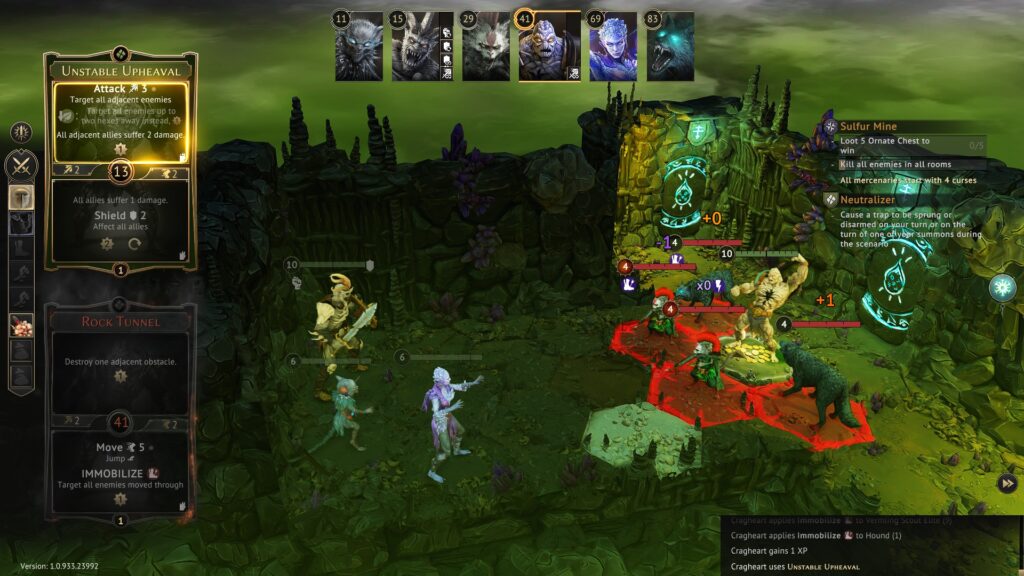
A GAME OF TOMBS: STRATEGY & TACTICS
Gameplay is a mix of strategy and tactical gameplay. Strategy take place between combat encounters on a large world map. Players choose the composition of their party from an initial pool of six archetypes such as: warrior, rogue, spellcaster, tank, summoner, psychic and support. An additional eleven more can be unlocked later. The party is moved to the next quest location on a world map.
Deciding upon the order to undertake those quests that are available. Sometimes reacting to narrative-led, choice-driven encounters that appear randomly as the party travels. Which may or may not give rewards or bestow penalties depending on the choices made. Before committing to the battle equipment can also be assigned to individual mercs via a limited slot inventory. Each merc must also choose one of two personal objectives which if achieved award xp in the GM mode and perk points in the campaign.
THE ART OF WAR: COMBAT
Combat encounters are a turn-based, tactical affair. Fought against an array of enemy combatants. Each distinguished by a difficulty level, an attack mode plus their own strengths and weaknesses. Where all participants alternate their actions across numerous initiative-delimited rounds using melee, ranged and magical attacks; and a complex menagerie of positioning, and combat actions encompassed through cards.
Deck modifiers and can have an impact on the damage caused and combat statuses can be inflicted on combatants to affect their ability to fight and move. Battles takes place on fully rotating, hexagonal grid maps consisting of several tile-sets usually spread across a small number of rooms depending on the quest type. Objectives range from: opening a number of chests, eliminating all enemies or killing a number across a number of waves.
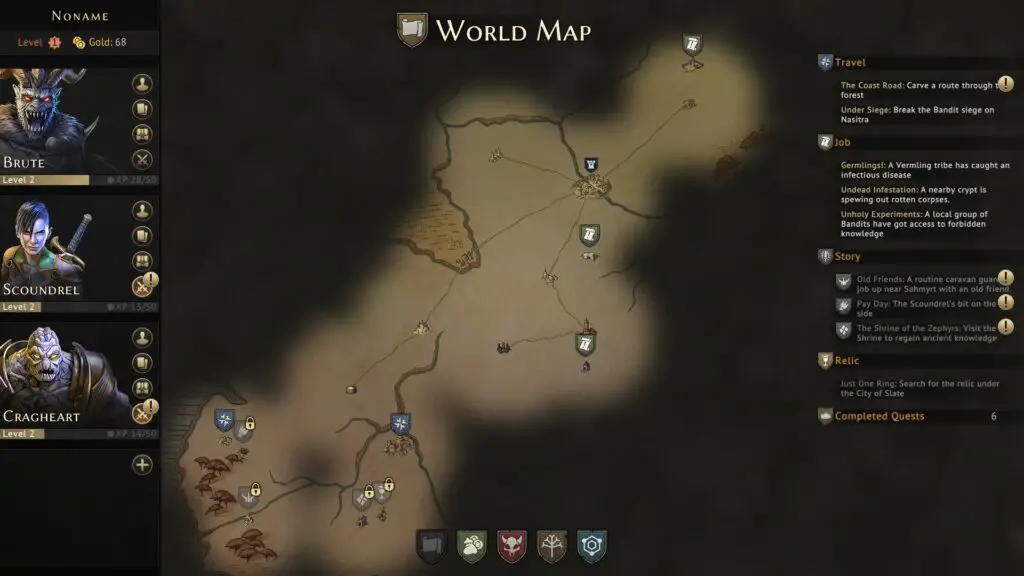
ITS ALL IN THE HAND: CARDS & DECKS
Central to combat is the deck system that comprises of 9-12 cards per character, depending on the mercenary. Customisable outside of combat additional cards can be unlocked to replace existing cards in decks, to alter the character’s tactical options. Each deck possesses a standard set of perks; damage modifiers and applicable combat statuses which can come into play when the cards they are assigned to are used. A further design element uses the number of available cards to determine the permissible length of combat a character can stay in the fight. So when not enough cards can be drawn, the character retires from the battle.
Before every round is initiated players choose two cards from those available for each mercenary, to use during their turn. The first card selected also determines the initiative score and the character’s sequence in the coming round. Cards are split into two sections, each containing one or more wide-ranging tactical actions to employ during the turn. These can be any of the following: movement, looting, attacking, defending, healing are among the most common options. Some cards possess combinations of multiple actions which allow for some widely complicated tactical approaches to combat.
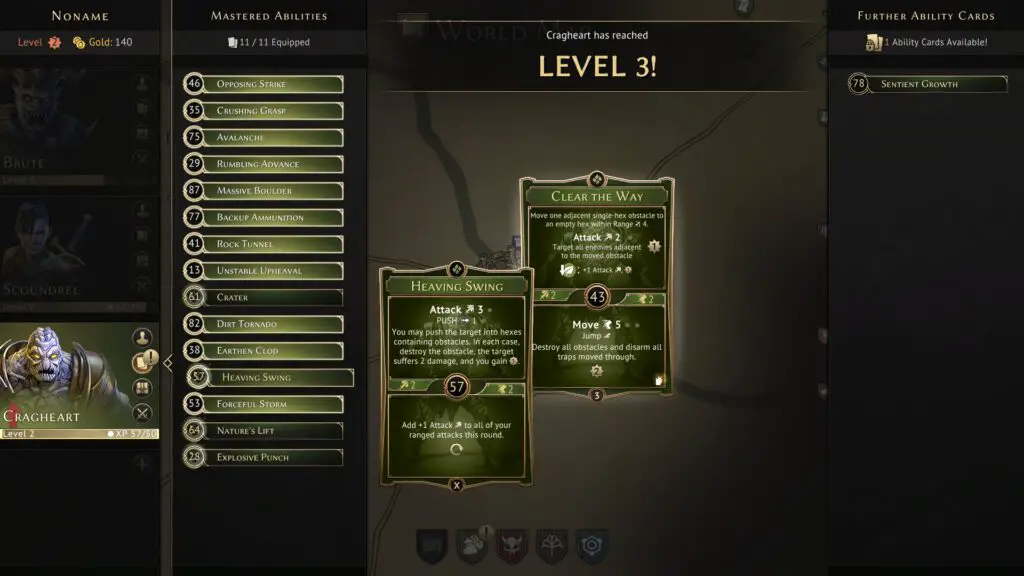
AN EYE FOR DETAIL: ELEMENTS, PERKS & MODIFIERS
This process sees a card go from being available in the hand, to being discarded when used. When all cards have been discarded, they are recycled at the cost of eliminating one card. This takes that card out of play for the duration of the encounter. When all cards in the deck are burned, the mercenary’s fight is over. In addition damage can be mitigated by burning available or discarded cards. Saving the character from taking any damage but at the cost of potential fight time. Valuable cards can be replaced with other ones but for the additional loss of health. Whatever option is chosen characters are never killed outright. They become exhausted and are removed from the field of battle. If the entire party becomes exhausted, they are forced to retreat to retry again.
In Gloomhaven perks are essentially a set of passive deck modifiers that provide some RNG to proceedings by affecting the damage rendered from a card’s action. Causing zero to double the damage. They can also apply certain combat statuses to a target causing: stun, disarm, muddle, poison and immobilise. Affecting the capabilities of those affected. These modifiers can be modified by use of perk points gained when a character levels up (or in the case of the campaign, completes personal quests.) Magic plays a relatively limited part in the game, essentially incorporated into the tactical combat. It’s only present availability comes in the form of action of cards for certain archetypes. There is more than one type of magic available which are incorporated into some of the cards. As well as attacks creatures controlled by psychic magic or can be used to summoned temporary allies.
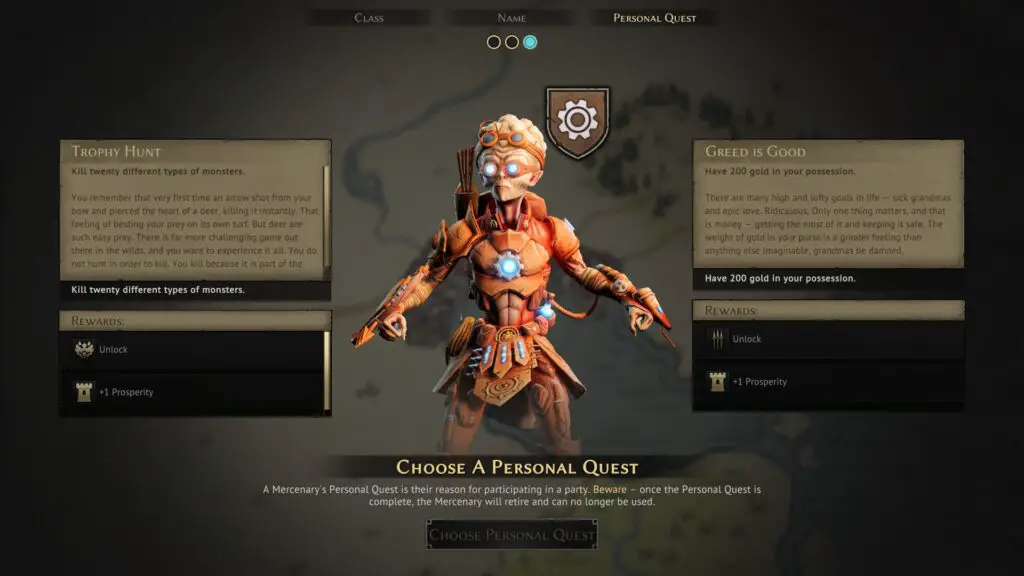
As certain cards are played during the course of an encounter, elemental power-ups are generated. These can be utilised by certain cards for additional actions or to augment existing ones. A host of tactical mechanics further enhance possible battle dynamics expanding the combat experience. The inclusion of factors such as: friendly fire, isolated targets, flanked targets, armour piercing, penetration and area of effect attacks provide players with an extensive armoury of options when planning their turns. Shields and retaliatory actions allow for some defensive strategies for some characters.
ASKING FOR HELP: HUB SERVICES
Between encounters players benefit from utilising the services of a merchant, priestess, enchantress or trainer. Merchants provide the facilities to purchase new items or sell unwanted ones. As each mercenary gains experience, trainers can be visited to gain perks, additional cards and customise the inherent modifiers of a mercenary’s deck. There are also a swathe of internal achievements based on in-game activities which when unlocked release additional archetypes to play, reward the party with gold or some other function.
Temples can be visited to receive blessings to gain a bonus for the next dungeon for a character. With every visit the devotion level of the mercenary rises rewarding the player with new item designs. Visiting the enchantress allows the upgrading of deck-held cards for a price. Augmenting a single aspect of the card such as increased healing, movement, damage or whatever. Taking a fairly ordinary card to another level.
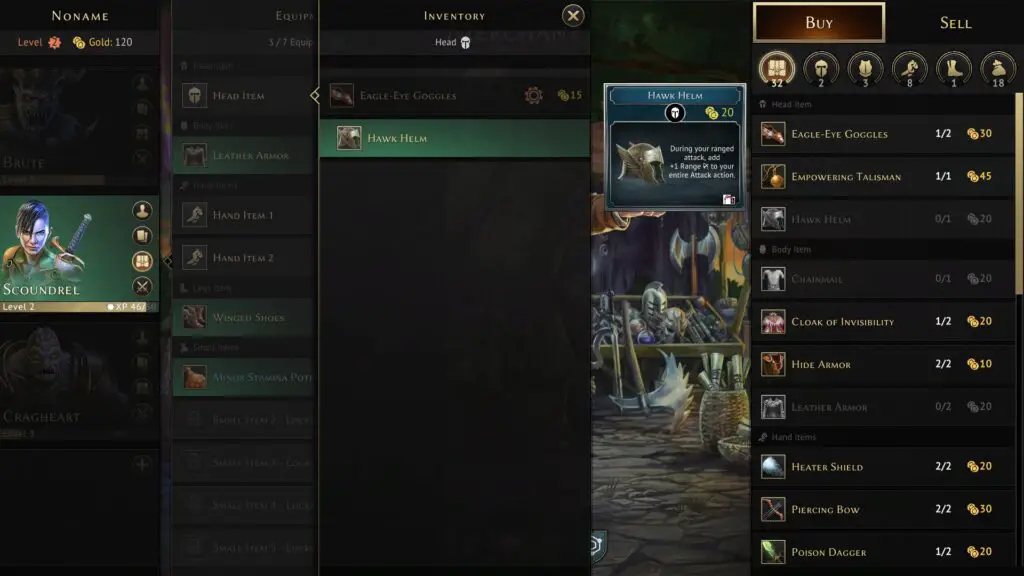
Players can assign up to six classes of equipment to a limited inventory of slots. These are purchased from the merchant using gold acquired while questing. Additional items can unlocked in chests found in dungeons or through generating prosperity and devotion in the campaign mode. Helmets, armour, weapons and shields join a number of smaller items that provide or augment tactical options during encounters. Allowing card abilities to be enhanced, such as ranges of effect, healing or damage delivered increased or damage taken decreased. Making the difference in right situations.
THE GOOD:
- A complete and faithful adaptation of the boardgame.
- Fun but challenging gameplay.
- Good mix of strategic and tactical elements
- Built for longevity and lots of replayability.
- Nice clean graphics and art-work reflective of the source material.
- Immense range of tactical deck mechanics requiring the correctly synergised cards pairs.
- Good range of archetypes to choose from: 17x playable characters. 6x immediately available. 11x to unlock by performing quests.
- A strong bestiary of opponents. 47x enemy classes with multiple levels of difficulty, attack modes, strengths and weaknesses. Plus 7x bosses to defeat.
- Modding & level editor allow for the creation of additional content to expand the experience. Essentially a way for the fandom to create its own adventures/campaigns.
- A very forgiving design. Mercs are unable to die permanently and only retire when a quests fails.
- A more accessible Guildmaster mode with a fairly low learning curve, that plays somewhat like a sandbox.
THE BAD:
- An overly difficult campaign will likely be off-putting to non-fans of hardcore turn-based tactical games and non-fans of the boardgame. *** A new ‘easiest’ difficult now included in the latest update.
- Scenarios can feel puzzle-like in nature requiring the ‘correct’ selection of archetypes and cards in their decks to overcome.
- Needs more tile-sets. Currently there are only three: Mountains, Forest & Dungeon that can become overfamiliar with extended play.
- Having to loot for gold may be by design but micromanagement isn’t fun. Could have done with using an alternative method.
- Devs have been clearing 20x pages of reported bugs in their bug reporting sub-forum.
- GUI design requires confirmation for wasted or undoable actions.
- Could have done with a quest restart and a restart round. Currently can only abort quest or undo current action.
- High graphical settings may be demanding for some GPUs (i.e. 970GTX).
- Online play can suffer from disconnect issues.
AND THE REST:
- A overly difficult campaign mode with 95 story-linked scenarios with not enough differences from the Guildmaster mode.
- Playing online with a group of between 2-4 players brings another dimension to gameplay.
- Decent accessibly with in-depth how-to-play info screens and tutorials providing a solid introduction for newcomers. Just enough to begin playing.
- Decent configuration settings allows for a good deal of customisation.
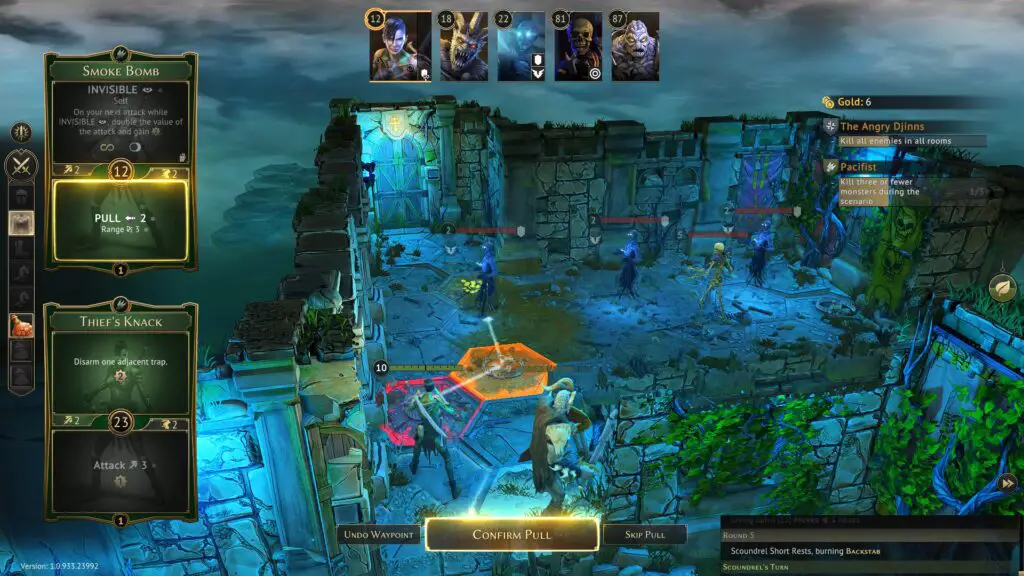
ANALYSIS:
*** This analysis comes from the viewpoint of someone who has not played the physical boardgame. If only I had the time! ^^ ***
Gloomhaven succeeded on many levels given the ambitious nature of porting such a meritorious progenitor. Providing a mostly compelling experience. Frustrating in part. Yet faithful in its adaptation. Even comprehensive in its delivery. Possessing the hallmark of great design. One sure to have matched the excellence of the boardgame. The result of collaboration with the original creator. However there were a few factors that did not sit right and could potentially put off interested parties.
Graphically this was a good looking game with visuals that built upon the art of the boardgame. Bringing its gameworld to life. Seemingly possessing a look and aesthetic remindful of Stone Prophet. One of my favourite AD&D dungeon crawlers from the 90s. Reinforced by 3D character models that delivered representative figures for every archetype and enemy.
Alternative skins opened up the possibilities to personalise their appearance further. Even if these are limited to only one other for the time being. With only a small number of tile-sets there was a distinct lack of scenic diversity. Overall the immersion was above average which is fair for what is a essentially a boardgame.
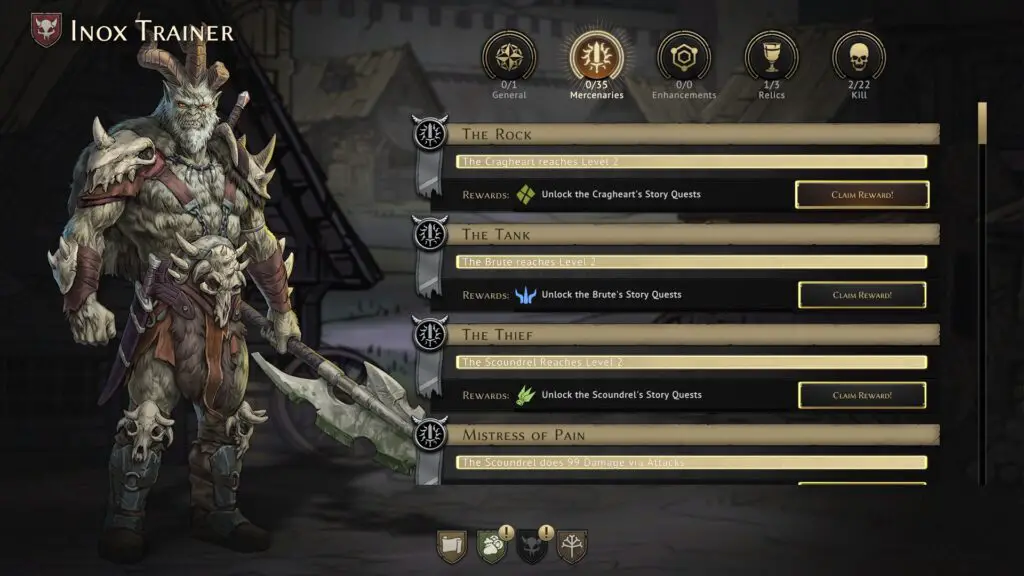
Combat the mainstay of gameplay proved to be a satisfying feature. Plied with layers of mechanics that allowed for many potential strategies. Card driven tactics in particular were surprisingly varied given they were built on a limited core of actions. The nuanced variants substantially extending the range of possibilities. Passive deck modifiers provided some RNG resulting in a suitable range of damage and the chance to score effects on targets.
While the small pool of inventory items provided the tactical augments to slightly exceed the fixed limitations of certain cards. Providing critical assists when cards alone would have not been useable or just short of achieving the desired effect. Resulting in wasted cards. Overall combat rounds felt mostly balanced in nature. At least in Guildmaster mode. The campaign was another story.
The basis of the card system and the decks were very easy to understand. Making gameplay very accessible. Yet as per the best tactical games, mastering card combinations and achieving synergies would prove a very time-consuming task. Indeed it felt that failing quests repeatedly was part of the design. One which embraced a unforgiving nature that is sure to appeal to more casual gamers.
Even if this means spending more time with the game. Undoubtedly its one of the game’s best qualities. With characters unable to die players could just enjoy playing the game. Trying new approaches. Experimenting with different archetypes and deck setups. Learning the game at their own pace.
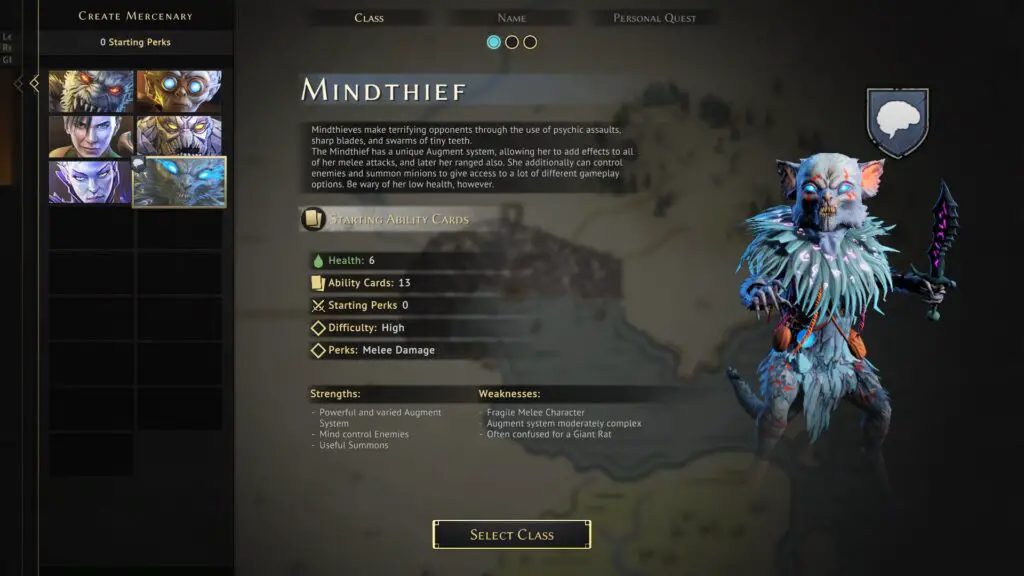
Reversion features were present to lessen mistakes made. Quests could be abandoned without penalty and re-attempted. The gold, items and XP gained in the aborted quests were retained. Allowing characters to eventually level-up and gear up to retry as many times as needed to progress to the next quest. Something that proved invaluable in the campaign mode, moreso than in the Guildmaster mode. Specific rounds could also be reverted. While individual actions could be undone before they were committed to. Unfortunately the ability to undo a specific mercenary’s turn was unavailable. Potentially causing players to have to repeat the entire round over and over.
Rather than playing like a standard TBT game, the nature of encounters was very much like unravelling a puzzle. Especially in the campaign mode. An important distinction as it almost certainly amplified the difficulty of the game if it were not approached as a boardgame. It should be noted that rather than just eliminating enemies or achieving a set of objectives, these must be achieved before the health and cards of the mercenaries in the group run out. As a consequence quests in this mode had an almost pre-determined quality. Whereupon choosing the wrong mix or the wrong number of archetypes, or customising the deck with the ‘wrong’ set of cards could lead to a virtually unwinnable scenario. At least for starting players.
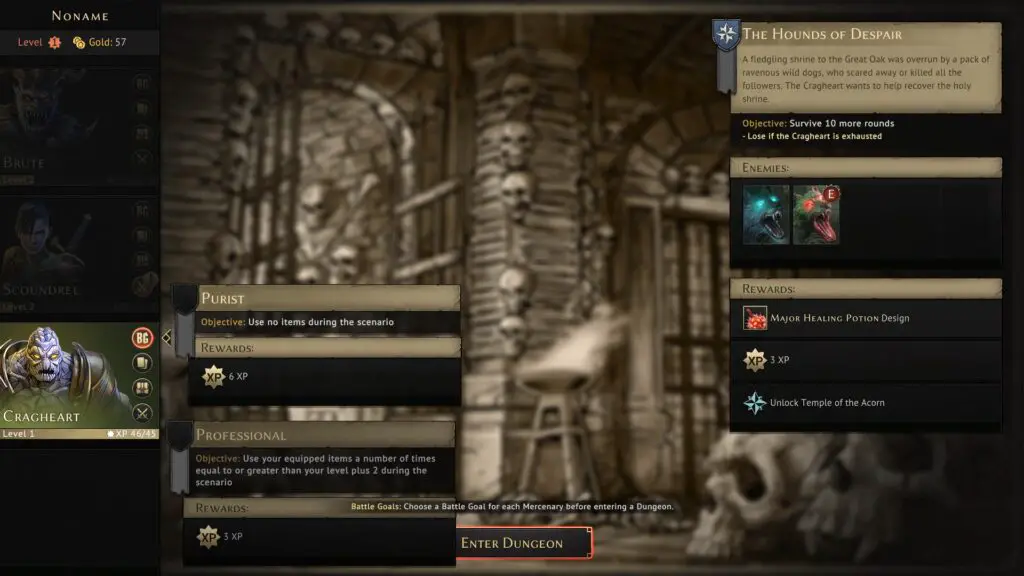
It took thirteenth attempts on normal difficulty to eventually overcome the first quest in the campaign. By then rather than go with a smaller party (as hinted at), a full one was gathered with a better mix of mercenaries and better synergised cards. One of my gripes with the deck system was the way cards had to be drawn for the next turn. Rather than have all cards available to the player. This meant alot of cards could be wasted. A common occurrence when the precise nature of the next round could not be accurately predicted during the card selection phase.
This would result in shifting the initiative elsewhere and very likely making the game easier to play. Personally I could imagine a more fun time for everyone bar hardcore players. It would definitely change the game alot. Too much maybe. Though it could have perhaps awarded the Guildmaster mode more of a unique identity.
Tactical elements within map environments were limited. Apart from mercenaries, summoned allies and opponents; only doors, traps and the odd obstacle to restrict movement and melee combat were present. Other considerations were limited to having to collect chests and piles of dropped gold through positioning and/or card actions. Given its boardgame roots this was unsurprising but disappointing. An element of design that allowed the focus to remain on the card system. Causing the requirement for restricted map-sizes to at most a dozen extra rooms to limit how many cards were actually spend on movement rather than fighting, healing, defending, gathering gold and other actions.
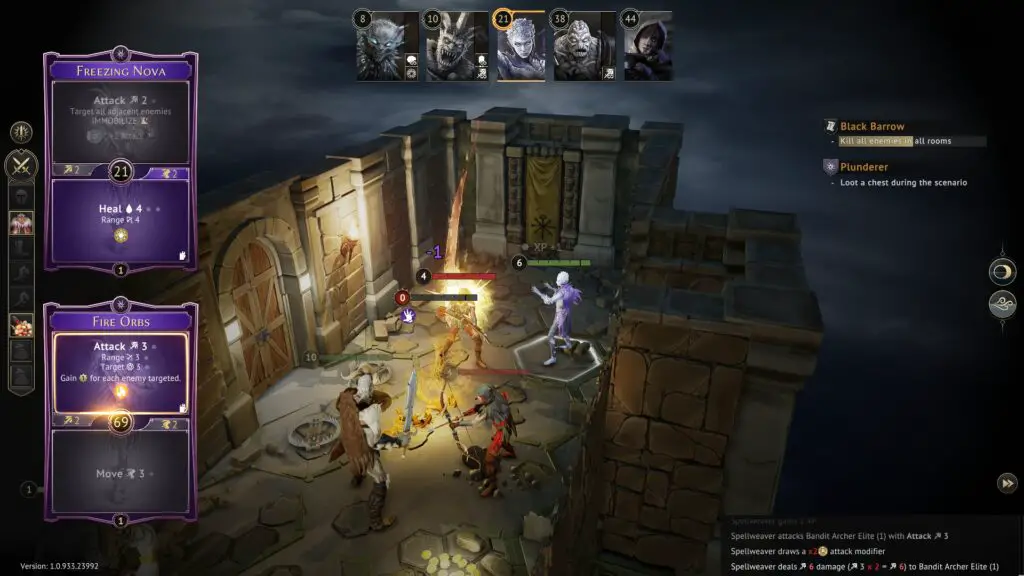
The similarity of the two modes in Gloomhaven was perplexing at first. However with time spent playing both it became clear that the campaign was based, if not taken directly from the boardgame. In this respect it has story-linked quests rather than a sandbox format. It is also a much harder prospect to play. Its more puzzle-like feature already covered. Characters would also adopt a personal quest when joining the player’s group which once completed would see the mercenary retire and have to be replaced by a new character. Giving greater emphasis on the need to have more than four (up to seventeen) mercenaries in the company pool.
The range of enemies seemed quite restrictive at first. With the same handful of types popping up in the first few dozen GM quests. However with 47 types plus bosses the variety of combatants is there. A fair amount of patience will be required to encounter them all. Each of those faced were distinct to a point. Ranged combatant proved deadly to exposed mercs. Fast moving hounds were able to surround and neutralised isolated team members. While stock infantry troops were able to switch between going on the offensive and using defensive actions to limit the player’s offensive strategies. This all pointed to a promising mix of future enemies when looking forwards.
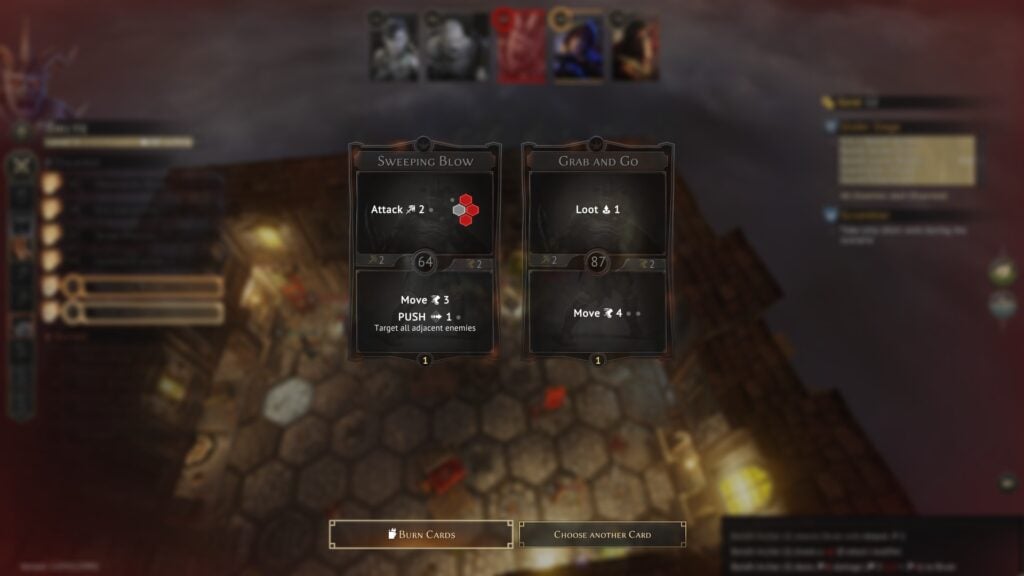
The game’s strategy elements do a great job of supporting the TBT combat. Possessing just enough substance to connect the inevitable sequence of repetitious encounters together. As each have their own distinct function there is no duplication. While the priestess feels underused, the ability of the enchantress to upgrade cards was one of the biggest highlights of Gh. A great feature that augments cards to alter the battle dynamics for particular mercenaries. Its just a shame that mercenaries with upgraded cards can retire. I wonder if these cards remain active for new instances of archetypes once they are added to the mercenary company? Otherwise these could be a short-lived benefit. One that perhaps reaches its pinnacle in the Guildmaster mode where retirement is relevant.
Internal achievements available through the trainer were a very satisfying feature. Given that they provided small rewards or unlocked an inventory item in the merchant’s screen. There were so many that they were divided into a handful of classes. As they work in parallel to the objectives gained from completing encounters, they provide the impetus to keep playing what is essentially the same core feature over and over. What’s more the developers have indicated that they can port these internal achievements and put them on Steam. Awarding those already gained by players in game. Hopefully at some time in the near future.
The GUI was logically spaced out making for a very accessible layout. Its biggest issue seemed to revolve around the need to confirm redundant actions. To go through the motions and complete full turns, even if no other actions were possible. This slowed the pace of the game down. Together all of these graphical components were instantly recognisable to other Asmodee titles such as Arkham Horror. A sure sign the same engine was used. Sound was less impactful with functional audio and a fairly benign soundtrack. Voice-overs used in campaign cutscenes were top grade. Presenting an overall ambience that generated a connection with Gh’s setting and nomadic styled theme.
By only spending forty hours with the game it was already clear that it has been designed and built for longevity and replayability. The sheer range of components from; mercenaries, decks of cards, inventory items, enemies and bosses very much pointed to this. There is also a very strong theme of recycling permeating through the entire game. Which generates an impression that every component has its own place in the make-up of Gh. Allowing the player to determine their preferred experience. One that they can change on subsequent play throughs.
Indeed with not all scenarios experienced during a campaign players could have at least in part, different scenarios to overcome a during their next playthrough. The content editor and modding support is just the very sizeable cherry on the cake that will likely allow owners to invest 100s if not 1000s of hours playing what is a remarkable game.
VERDICT:
Gloomhaven proved to be a very unique experience. At times difficult and frustrating. Yet built to be inviting through its accessibility and forgiving through its design, those interested in crawling through its immense amount of content are sure to enjoy what it brings to the table.
With immersive themes, settings and visuals it certainly proved enchanting to take a look at. The deep, layered, complexity generated by the copious mechanics make this a dream for fans of turn-based tactical games. Though it should be noted that on standard and higher difficulties in the campaign there is a strong level of pre-determination and a puzzle like quality to the gameplay.
Overall Gloomhaven proved to be a very COMPELLING game. For the few irritations and its sheer learning curve on what should be standard difficulties this would have been UNMISSABLE. As it it, casual gamers be wary; the Guildmaster mode will be enjoyable, the Campaign mode not so much.


